Ok, I’ll admit it. I love the sound of the camera clicking away!
I never know what opportunities await this camera addict, so my camera is always an extension of me, even if I’m going on a short adventure.
And when I am a passenger in a car (AND NEVER, EVER THE DRIVER), the camera seems to jump out of the camera bag and plunk itself right in my hands.
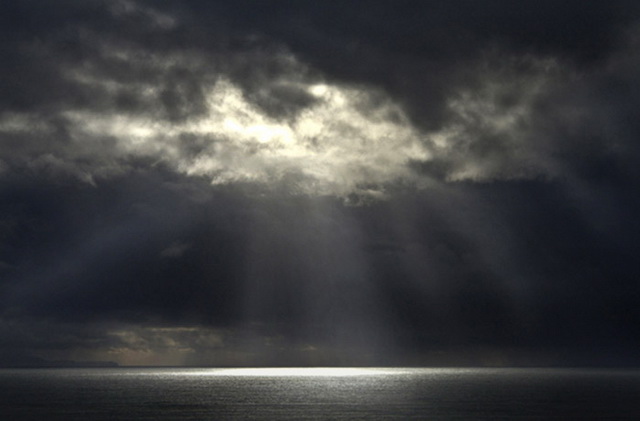
So a few weeks ago, I rode with my sister and friends up the California coast to a small community called Lompoc. Lompoc is a flower-growing center and approximately 2 hours north of Los Angeles. To get there you drive on a 54 mile stretch of US Highway 101 which runs directly along the coastline.
It is a spectacular scenic route and on clear days you can see the small islands just offshore and the oil rigs that dot the channel. Because it is a highway that was chiseled into the side of the rocky hills, there are no areas to stop or roads that turn off the highway. In fact, unless your car breaks down, you’re going to get a really big traffic ticket if you just stop to take in the view.
On this particular day we were in between a series of major Alaskan storms that had moved down the coast and were pounding California. When we left home it was clear, but on the way up the weather began to change.
As we were driving along this beautiful stretch of coastline, there were massive clouds gathering overhead but you could still clearly see the islands that appeared to be floating on the surface of the water. Close to the shore, the ocean had taken on the oddest shade of green-yellow-blue.
It’s my guess that the amazing color scheme was created when the storm churned up the ocean floor. So I clicked away… my addiction being excused by family and friends.
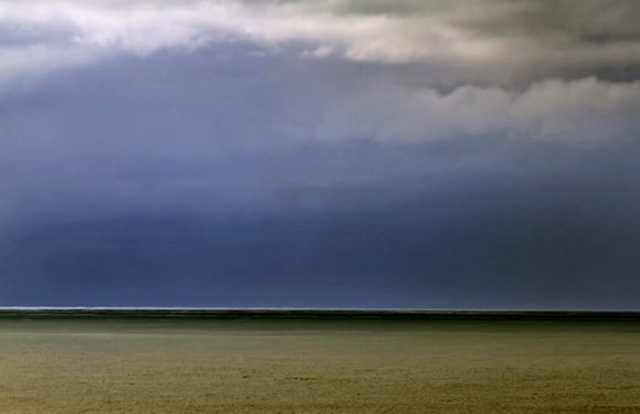
By mid-afternoon, after enjoying our excursion and being dappled by the rains from time to time, we headed back down the coast towards home. When we were once again traveling on the highway along the coast, I couldn’t believe what I was seeing and there was nowhere to stop the car! Mother Nature was at her most stormy best.
So what’s a girl with a camera going to do? The camera came up from my lap and I was off blasting away. I knew from the past that I would probably only grab these shots as a memory for myself–typically, most of my shots from moving vehicles end up in the trash.
But because I couldn’t keep the shots of the incredible storm to myself, I shared them with a couple other photo pals. Not only did they thoroughly enjoy receiving them, but they wanted to know how they too could capture images from a moving car, train, plane…
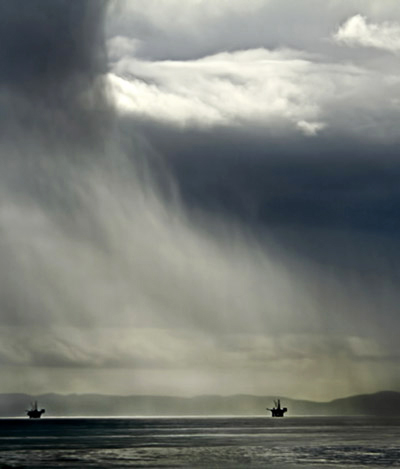
So if you have the same desire to shoot as I do and find yourself a passenger in a car, bus, plane, train or any other moving vehicle, here are some tips for you to try.
1. Think ahead and be prepared. Dress in dark colors so you won’t be competing with your own reflection in the window glass.
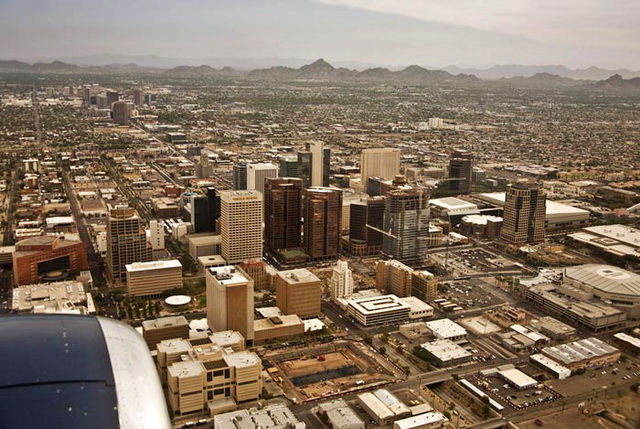
2. Where to sit: If you are traveling by plane, see if you can get a spot in front of the wing to avoid not only the wing blocking your view, but the exhaust trail from the engines. If you’re on a bus, I like to sit near the front so I can utilize both the side and front windows.
While you’re riding in the car, anywhere but in the driver’s seat, but again, you’ll have more options if you’re in the front seat. I never travel by train, so try to choose the best you can, as long as it’s by a window.
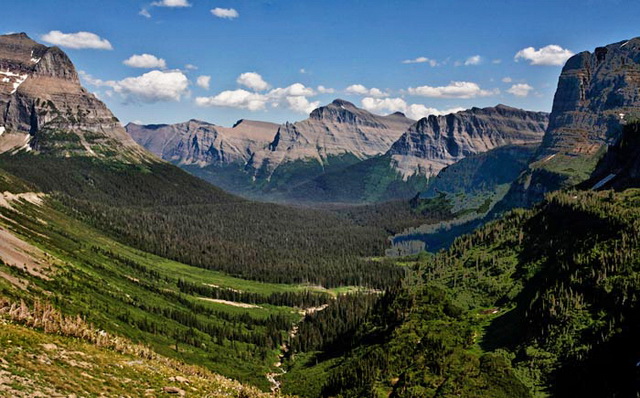
3. Regardless of what means of transportation, try to pick either the side away from the sun so you’re not shooting into the sun and/or on the most scenic side. Hopefully those will be the same side.
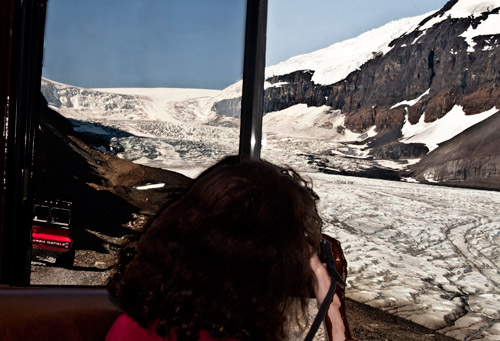
4. Try for a clean window if you can’t open the window. Carry a tissue or small towel with your camera gear so you can clean the inside if you need to do that.
5. Shoot at a slight angle so you won’t get a reflection or sun glare off the glass.
6. Bump up your ISO. You want to keep the aperture small enough to carry the scene, but still stop the motion. My best exposures were F8 or F5.6, with a minimum of 1/250 sec. shutter speed (1/500-1/1000 sec. preferred). Work your ISO so you can keep up speed and still maintain a good exposure.
7. Don’t try to brace yourself against the vehicle because you will only pick up vibrations from the body of the vehicle. Instead, lock your arms into your chest, while bracing your camera against your brow. This will help steady you and the camera.
8. Try to go for the more distant shot. If you include too much foreground, it will show movement and the closer the subject is to the car, the more blur will become a problem.
9. Aim either ahead of yourself or behind so that you don’t pick up the 90 degree (right-angle) close movement blur.
10. Try some shots in black and white or infra-red, so the color distortion cast from the tinted glass won’t become an issue.
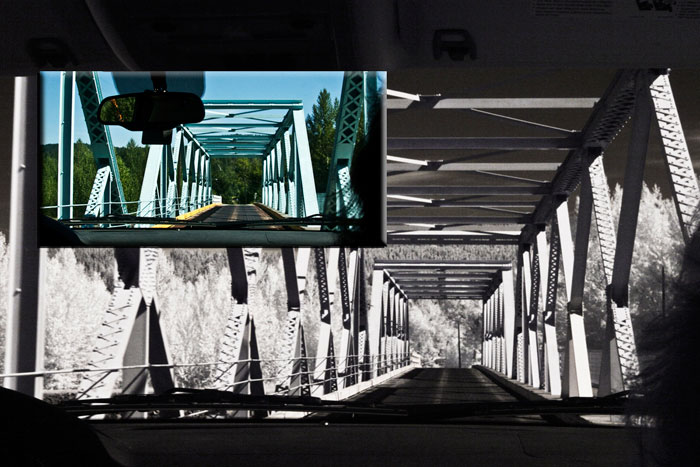
11. If you can’t fight motion, use it as a tool. Try deliberate blurring or panning. Experiment with other techniques and just have fun them.
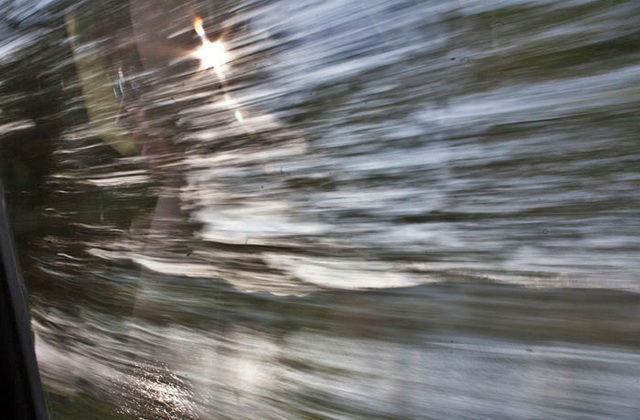
12. Be prepared and watchful … you can never tell what will come up fast.
O.K.–now I have indulged myself and I have lots and lots of images on the memory chip. Some will get deleted immediately, some will be definite keepers and some I’ll try to salvage. Remember, it’s ok to toss images and when you’re capturing images from within moving transportation, you will toss lots and lots of them. But let’s say I want to share something special or do something more with a casually taken image. So what happens next?
I use Adobe Photoshop software, but there are other programs out there to edit your images. Choose the one you like.
Here are some basic steps:
1. Correct the exposure if you need to do it with levels and curves … and sometimes you need to correct for the tint on the windows.
2. Crop off the parts that show movement or blur.
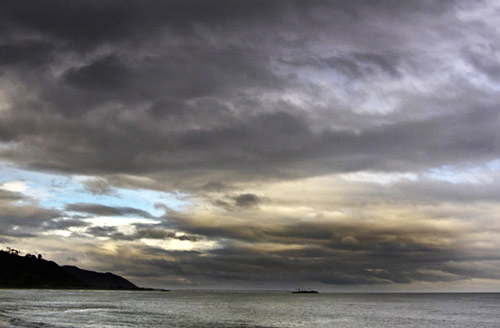
3. Try to correct the effect of noise. This is a common problem–remember I said to push that ISO up. These storm images were shot at ISO 800 through a tinted window, so there was a lot of noise.
There are some programs that act as a plug-in to Photoshop that have special functions like noise reduction. I tried that but it wasn’t enough.
So, I added a Gaussian blur but that took away any sharpness that I might have had.
I did both with some sharpening in between. When in doubt try it all, but be sure you are making any changes on duplicates of the image you like or you can lose your original image.
4. Switch your mind to the artistic mode. If you can’t get rid of the noise, learn to work with it to your advantage.
Dry brush is one of my favorite fix-it-artistically tools. It didn’t want to be a photograph so I turned it into a painting. Maybe it looks better as an oil painting, using the Palette Knife tool, or as a watercolor where noise adds to the effect. Try a variety or combination of techniques—have fun creating a beautiful effect.
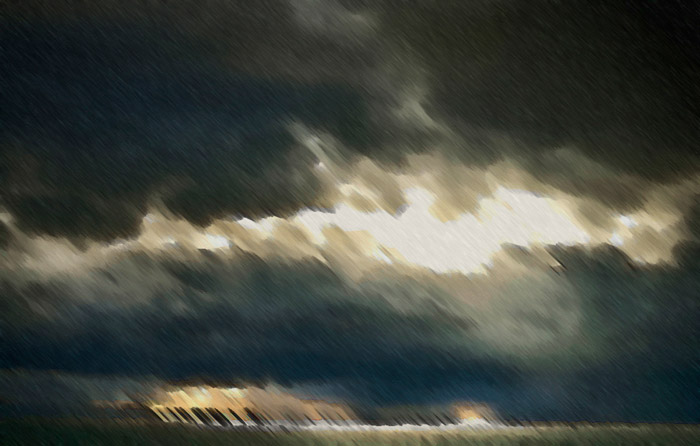
It’s really unimportant to me if the shots come out or not, although it is really nice when they do. What I love about this kind of shooting is that it makes your eye “see” and “compose” instantly. As you play with your camera, your fingers get to know every dial and button intimately.
You have no expectations, so you really don’t care about the end result. There is no stress–only finger knowledge and the ability to really get your eye sharpened up so that when you are shooting “seriously” it will intuitively come through your fingers to make your work unique.
Give it a try and have fun in the process, but remember, ONLY, AND I MEAN ONLY, WHEN YOU ARE A PASSENGER AND NOT THE DRIVER. I want you around to share those special moments with me.
by Noella Ballenger
All text and photos: © 2011 Noella Ballenger. All Rights Reserved.

Leave a Reply